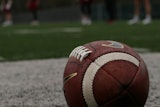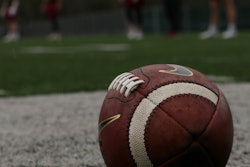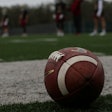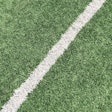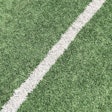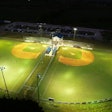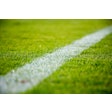From impact attenuation to accessibility, playground operators face a number of hard choices when specifying safety surfacing.
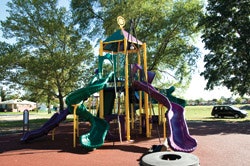
Despite all that, Detroit has emerged as a national model for forward thinking in one small but significant area: playground safety. According to Tim Karl, the city's chief of landscape architecture, Detroit continues to improve the safety of its 391 parks by renovating several each year. And not just to accepted ASTM International standards, either. Specifically, the Detroit Recreation Department's director and managers insist that safety surfacing installed in their parks performs better than required by ASTM at installation, as a means to ensure it will meet the minimum standards for head-injury protection even as the surface degrades over time. "We can easily put $60,000 into surfacing in one playground area," says Karl, referring to the poured-in-place synthetic material that the department prefers. "We want to get at least five years out of this stuff if we're putting that kind of money into it."
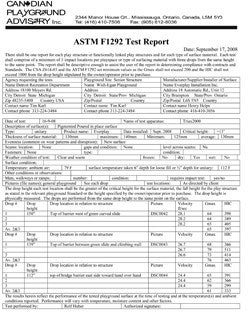
FALL EXAMS
The Triax 2000 is the only instrument capable of determining on site whether a surface is in compliance with ASTM International's impact-attenuation standards.
The Triax 2000 is the only instrument capable of determining on site whether a surface is in compliance with ASTM International's impact-attenuation standards.
But the department raises the safety bar farther still. Whereas the standards call for compliance as measured from fall heights corresponding to play equipment surfaces on which children are expected to stand (i.e., platforms and decks), Detroit Rec takes its measurements from the tops of railings, adding another 38 inches or so to drop heights and thus challenging surface performance that much more. "If they're going to jump off the equipment, they're going to go from the railings," Karl says. "They may try to do a tightrope walk, and if they fall, we can say we've been proactive."
Adds Rolf Huber, president of both surfacing manufacturer EverPlay and Canadian Playground Advisory Inc., a surface testing organization, "For a city that gets ridiculed for all its financial woes, at the park and recreation level Detroit has been phenomenal in terms of best practices in this sort of quality-of-life area."
Municipalities everywhere would be wise to follow the Motor City's lead. It is estimated that 200,000 children are treated annually in emergency rooms in the United States for injuries suffered on playgrounds, and dozens of those children never make it home. Experts, including Huber, believe that the oft-quoted injury total would more than double if visits to school nurses, family practitioners, clinics and urgent care centers were factored. The vast majority of all reported injuries, it turns out, are related to surface falls.
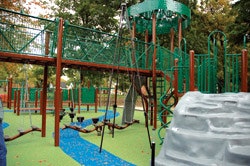
CHALLENGE COURSE
Experts argue that investment in high-quality safety surfacing, as opposed to lower-profile play structures, better serves children.
Experts argue that investment in high-quality safety surfacing, as opposed to lower-profile play structures, better serves children.
How playground operators go about meeting that standard of care varies, as several varieties of surfacing media will produce the requisite impact attenuation. These include poured-in-place synthetic materials (usually shredded rubber bound by polyurethane), loose-laid shredded rubber, rubber tiles, synthetic turf, polyurethane-bound or loose-laid engineered wood fiber, wood chips, sand and pea gravel. Underlayments of closed-cell foam may be incorporated to enhance resiliency and drainage in systems employing tiles or turf, and several inches of gravel sandwiched between layers of landscape fabric can add decomposition-fighting drainage beneath wood material, which is often installed at depths of 12 inches or more. Quasi-hybrids are available, too. One product incorporates bags of loose rubber laid side by side and covered with a sheet of PVC.
Each surface has its selling points. Synthetic products are virtually maintenance-free, save for instances of vandalism, but are the most expensive at roughly $8 to $10 per square foot. They can also prove susceptible to natural degradation due to temperature fluctuations, standing water, ultraviolet rays and the migration of silt, not to mention heavy foot traffic. Conversely, loose-laid products require regular maintenance to redistribute material that has been kicked out from underneath swings and other potential fall areas. Engineered wood fiber, shredded in such a way as to cover playgrounds with a deep but relatively stable thatch layer, costs as little as $1.50 per square foot initially but must be supplemented with new material annually (or at least every other year) to maintain proper depth.
Moreover, the impact-attenuation properties of wood, which is used in an estimated 85 to 90 percent of all playgrounds, can also be compromised as the seasons change. "The problem is the cusp of spring, when surfaces may not yet be working perfectly," Huber says, pointing to cold-weather climes where children are eager to seek relief from cabin fever. "The city of Calgary has banned wood chips, the reason being that they get what are called Chinooks - warm winds that come over the mountains - and they'll have 75-degree weather for two days. Most owners do not understand that wood systems are insulating. A lot of them walk across the playground and say, 'Look, the wood chips are loose.' Sure, the top inch-and-a-half is loose, but the bottom 12 inches is a solid block of ice."
Whatever the surface of choice, end users must be aware of what they're buying and how it should perform once installed. Rounded sand makes for a suitably forgiving playground surface; angular sand of the type used as a base layer for paving parking lots does not. Playground operators must beware also of the potential for installation chicanery, particularly when poured-in-place synthetic products are involved. "We've had cases where someone orders a seven-inch-thick surface, the installer only puts down four inches and sells the other three inches to somebody else. By looking at it, you couldn't tell," says Paul Bamburak, president of Trenton, N.J.-based Alpha Automation, manufacturer of the Triax 2000, the lone instrument recognized by ASTM as capable of accurately measuring playground impact attenuation on site. "The only way previously to get surfacing tested was to physically cut out a chunk of your new playground and send it to a lab."
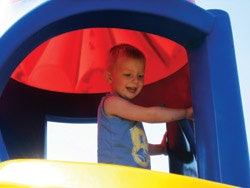
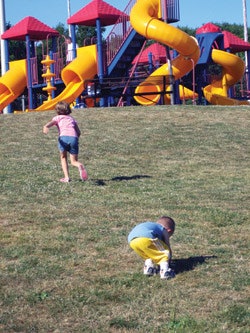
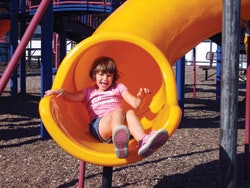
THE CHIPS ARE DOWN
An estimated 85 to 90 percent of all playgrounds employ some form of wood surfacing, requiring regular redistribution and replacement of material.
An estimated 85 to 90 percent of all playgrounds employ some form of wood surfacing, requiring regular redistribution and replacement of material.
The association's web site (www.ipema.org) allows end users to search a database of companies and their products, providing such information as surface thickness and at what fall height the surface will meet impact-attenuation standards. Passage of independent, third-party lab testing performed by Detroit Testing Laboratory Inc. is sufficient to secure certification in most cases. However, IPEMA five years ago began subjecting poured-in-place surfaces to onsite testing before issuing certification. In addition, training programs for installation crew chiefs must undergo IPEMA certification before poured-in-place products receive the association's seal of approval.
But it's not enough just to be deemed safe; a playground surface, in accordance with federal law, must also be accessible. An industry standard exists (ASTM F 1951 Standard Specification for Determination of Accessibility of Surface Systems Under and Around Playground Equipment), as does an instrument that can simulate in the field a wheelchair's ability to traverse a surface, yet IPEMA so far has been unable to rally all manufacturers around a suitable testing procedure for playground-surface accessibility certification. Meanwhile, the United States Access Board is currently "up in arms over not having a field test for accessibility," according to Illjes, who calls accessibility certification the playground industry's latest hot-button issue.
Park planners may face their own accessibility dilemmas. "If you can afford them, the tiles and the poured-in-place systems are accessible," Illjes says. "The engineered wood fiber is accessible, but it's on the challenging side for people with disabilities. If you're going to put a playground in and you have 200 children in the area and one child with a disability, your decision is this: Do you put in a really nice playground that handles 200 children in terms of playground equipment and a wood-fiber safety surface, or do you make the playground one-fourth the size and spend half your budget on poured-in-place surfacing?"
DeFillippo adds something else to think about. "It may not be the child who needs the wheelchair assistance, but rather the caregiver. Would you want to be viewing your injured child and not be able to reach that child? That's a pretty tough pill to swallow."
From a pure accessibility standpoint, one might deduce that the days of sand and pea gravel as playground surfacing media are numbered. DeFillippo, for one, isn't ready to go there just yet. "We can't make those kinds of grandiose statements," he says. "What I think is going to occur is that sand is going to move from a playground surface to a ground-level play activity. So we'll have sandboxes, we just won't use sand as a fall-absorbing material underneath structures. It's important that our playgrounds have multiple surfaces, so that children can migrate through those different surfaces, just like in the real world."
One point that all can agree on: Today's state-of-the-art playgrounds are a far cry from the overtly unwelcoming variety that decades ago featured gray galvanized steel monkey bars anchored in asphalt. "You want to know what the rationale was in those days?" asks Huber. "There are risks in life, kids are going to have to deal with life-threatening risks, and where better to learn that than on a playground? I've had people explain that to me, and I'm like, 'You've got to be kidding.' So, you're prepared for everyone to sit around and say, 'Oh, look. Johnnie split his head open. I don't think he's going to hang upside down anymore. I think he's learned a life lesson.'"
Not that the asphalt jungle gym is entirely extinct. Detroit still has its share, but the city is working to tear them out in favor of more colorful parks with plenty of cushion underfoot. Still, only so much can be done, and only so fast.
Some have suggested lowering the profile of play structures as an alternative to investment in safety surfacing, but Huber isn't buying. "Reducing the challenge on the playground, which is sort of the knee-jerk reaction, is not a good thing," he says. "Don't go away from the high stuff. Then you get kids falling out of trees because there's no challenge on the playground. Instead, put a surface in that's protective."
"The CPSC approximates that about 70 to 80 percent of playground accidents are falls," adds DeFillippo. "In a time when our staffs and our resources are limited in trying to protect these children, we should focus our efforts on surfacing. If we can eliminate, at minimum, seven out of every 10 accidents, we've really done a good job."














